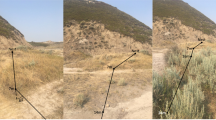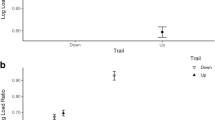Abstract
Linepithema humile (Mayr, 1868) ants self-organize mass recruitment to food sources by laying pheromone trails to direct foragers. Initial exploration may occur randomly, but selection of the shortest route is often derived from positive feedback mechanisms rather than individual intelligence or decision-making. In this study, we examined whether L. humile foraging routes minimize travel distance and maximize linearity (i.e., have the fewest turns). Colonies of L. humile foraged in an artificial grid containing a number of possible routes to a long-lasting food source. In the design, there were three possible shortest routes that varied only in the number of turns that the ants had to make. The majority of foraging ants preferred one of the three shortest routes to the food, and significantly favored the path with the fewest turns. Selection of the shortest, straightest route may maximize mass recruitment to the food source by decreasing the chance of foraging ants losing the trail.


Similar content being viewed by others
References
Beckers R, Goss S, Deneubourg JL, Pasteels JM (1989) Colony size, communication, and ant foraging strategy. Psyche 96:239–256
Beckers R, Deneubourg JL, Goss S (1992) Trails and U-turns in the selection of a path by the ant Lasius niger. J Theor Biol 159:397–415
Buhl J, Miller E, Persay S, Alinvi O, Sumpter D (2009) Shape and efficiency of wood ant foraging networks. Behav Ecol Sociobiol 63:451–460
Collignon B, Detrain C (2009) Distributed leadership and adaptive decision-making in the ant Tetramorium caespitum. Proc R Soc Lond B 277:1267–1273
Czaczkes TJ, Grüter C, Ellis L, Wood E, Ratnieks FLW (2013) Ant foraging on complex trails: route learning and the role of trail pheromones in Lasius niger. J Exp Biol 216:188–197
Deneubourg JL, Aron S, Goss S, Pasteels JM (1989a) The self-organizing exploratory pattern of the Argentine ant. J Ins Behav 3:159–168
Deneubourg JL, Goss S, Franks N, Pasteels JM (1989b) The blind leading the blind: modeling chemically mediated army ant raid patterns. J Ins Behav 2:719–725
Denny AJ, Wright J, Grief B (2001) Foraging efficiency in the wood ant, Formica rufa: is time of the essence in trail following? Anim Behav 62:139–146
Detrain C, Natan C, Deneubourg JL (2001) The influence of the physical environment on the self organised foraging patterns of ants. Naturwissen 88:171–174
Dussutour A, Deneubourg JL, Fourcassie V (2005) Amplification of individual preferences in a social context: the case of wall-following in ants. Proc R Soc Lond B 272:705–714
Gerbier G, Garnier S, Rieu C, Theraulaz G, Fourcassie V (2008) Are ants sensitive to the geometry of tunnel bifurcation? Anim Cogn 11:637–642
Grueter C, Maitre D, Blakey A, Cole R, Ratnieks FLW (2015) Collective decision making in a heterogeneous environment: Lasius niger colonies preferentially forage at easy to learn locations. Anim Behav 104:189–195
Hölldobler B (1976) Recruitment behavior, home range orientation and territoriality in harvester ants, Pogonomyrmex. Behav Ecol Sociobiol 1:3–44
Jackson DE, Holcombe M, Ratnieks FLW (2004) Knowing which way to go—trail geometry polarity to any foraging networks. Nature 432:907–909
Nicolis SC, Deneubourg JL (1999) Emerging patterns and food recruitment in ants: an analytical study. J Theor Biol 198:575–592
Nonacs P (1991) Exploratory behavior of Lasius pallitarsis ants encountering novel areas. Insect Soc 38:345–349
Reid CR, Sumpter DJT, Beekman M (2011) Optimisation in a natural system: Argentine ants solve the towers of Hanoi. J Exp Biol 214:50–58
Schweitzer F, Lao K, Family F (1997) Active random walkers simulate trunk trail formation by ants. BioSystems 41:153–166
Vela-Perez M, Fontelos MA, Velazquez JJL (2011) Ant foraging and minimal paths in simple graphs. ArXiv:1103.1612 (q-bio.PE)
Vittori K, Talbot G, Gautrais J, Fourcassie V, Araujoa A, Theraulaz G (2006) Path efficiency of ant foraging trails in an artificial network. J Theor Biol 239:507–515
Author information
Authors and Affiliations
Corresponding author
Rights and permissions
About this article
Cite this article
Yates, A.A., Nonacs, P. Preference for straight-line paths in recruitment trail formation of the Argentine ant, Linepithema humile . Insect. Soc. 63, 501–505 (2016). https://doi.org/10.1007/s00040-016-0492-0
Received:
Revised:
Accepted:
Published:
Issue Date:
DOI: https://doi.org/10.1007/s00040-016-0492-0




